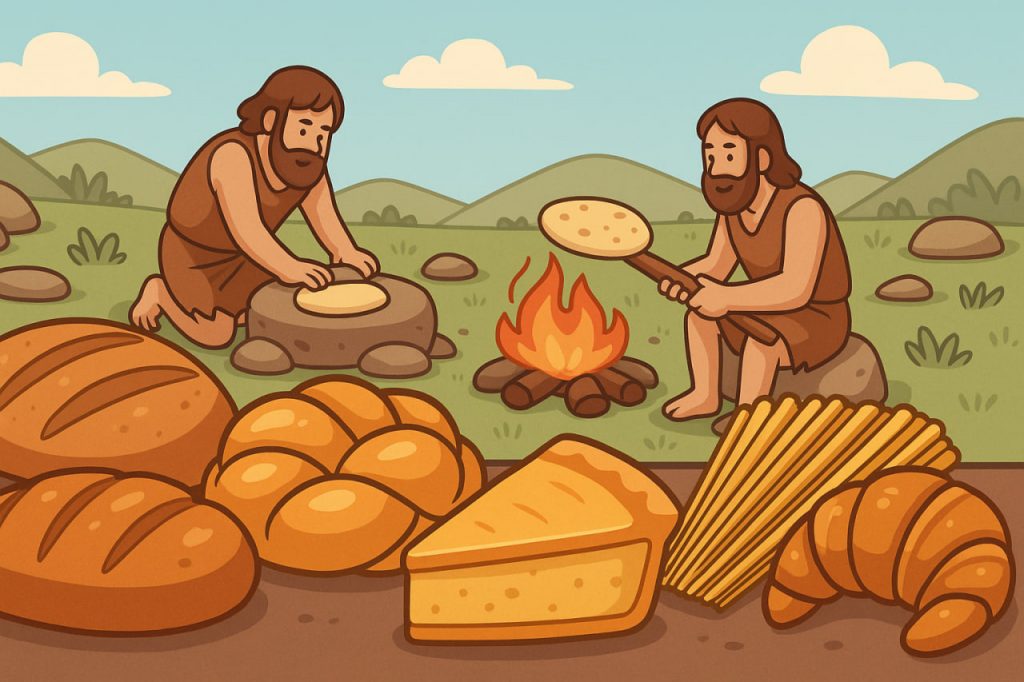Flour-based products — bread, pastries, pasta, and other baked goods — are among the oldest and most universal foods in human history. Their origins go back thousands of years, and their popularity today reflects a combination of nutritional value, practicality, and cultural tradition.
1. The Origins of Flour and Bread
- The first use of ground grains dates back to about 30,000 years ago, when early humans crushed wild seeds and grasses into coarse flour.
- The oldest traces of bread come from the Neolithic period (around 10,000 years ago), when people learned to cultivate wheat and barley.
- Early flatbreads were simple mixtures of ground grains and water, baked on hot stones or in ashes.
- With the discovery of fermentation, ancient Egyptians (around 3,500 BCE) developed the first leavened bread, giving rise to fluffy loaves.
2. Spread Across Civilizations
- Mesopotamia and the Indus Valley cultivated grains and baked breads as staple foods.
- Romans refined bread-making with mills and ovens, making bread central to urban diets.
- In Asia, wheat and rice flour led to the invention of noodles and dumplings.
- Middle Eastern and Mediterranean cultures developed pita, lavash, and other flatbreads still eaten today.
3. Why Flour-Based Foods Became Universal
- Nutritional Value – Grains provide carbohydrates, proteins, fiber, and minerals.
- Storage – Dried flour lasts a long time and is easy to transport.
- Versatility – Flour can be used in bread, pasta, pastries, porridges, and even sauces.
- Cultural Tradition – Bread and baked goods hold symbolic meaning in many religions and rituals.
- Economic Value – Grains became a foundation of agriculture, trade, and even taxation.
4. Industrial Revolution and Global Expansion
- In the 19th century, mechanized milling and modern ovens made bread and baked goods affordable and widely available.
- Flour-based products became staples in both urban and rural diets worldwide.
- Today, industrial bakeries and global trade ensure that flour products are accessible on every continent.
5. Modern Diversity of Flour Products
- Bread – from French baguettes to Middle Eastern flatbreads.
- Pasta and noodles – staples in Italian, Chinese, and Japanese cuisines.
- Pastries and cakes – found in nearly every culture, adapted with local flavors.
- Alternative flours – rye, corn, rice, chickpea, almond, and gluten-free blends for special diets.
Conclusion
Flour-based foods originated in early agriculture and quickly became a universal staple because they are nutritious, versatile, easy to store, and deeply rooted in culture. From ancient flatbreads to modern pastries, they reflect both the history of human civilization and the continuing creativity of global cuisine.
However, keep in mind that many unhealthy and harmful additives can be added to flour, and they may not be noticeable when looking at the crispy crust.
Glossary
- Fermentation – a process where yeast transforms sugars into gases, making dough rise.
- Flatbread – thin bread without leavening, baked on stones or in ovens.
- Staple food – a basic food eaten regularly in large amounts.
- Mill – a device for grinding grains into flour.
- Agriculture – farming practices including growing crops and raising animals.


